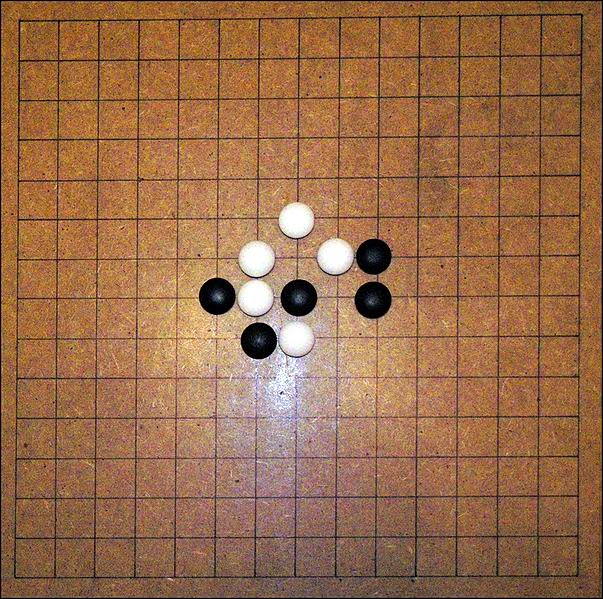|
Yamaguchi Opening Rule
Yamaguchi opening rule is a renju opening rule. It was developed by Japanese player Yusui Yamaguchi. Rule details The sequence of moves implied by the rule follows. * The first player (tentative black) puts one of the 26 openings and declares how many 5th moves will be offered in that game. * The next player (tentative white) has a right to swap. * The white player puts the 4th move anywhere on the board. * The black player puts as many 5th moves on the board as it was declared before (symmetrical moves not allowed). * The white player chooses one 5th from these offerings and plays the 6th move. Brief description This rule is very close to an old RIF opening rule RIF opening rule is a renju opening rule. It was adopted by the Renju International Federation The Renju International Federation (RIF) is an international organization which was founded in Stockholm, Sweden on August 8, 1988. The main purpose of ... and therefore favorited. It gives an average variety of new pla ... [...More Info...] [...Related Items...] OR: [Wikipedia] [Google] [Baidu] |
Renju
''Renju'' () is a professional variant of the abstract strategy board game gomoku. It was named renju by Japanese journalist Ruikou Kuroiwa (黒岩涙香) on December 6, 1899, in a Japanese newspaper ''Yorozu chouhou'' (萬朝報). The name "renju" means "connected pearls" in Japanese. The game is played with black and white stones on a 15×15 gridded go board. The rule of renju weakens the advantages for the first player (Black) in gomoku by adding special restrictions for Black. Rules Renju has its origins in gomoku and therefore shares most of its rules. There are two key differences between these games, however. First, renju has the rule of forbidden moves to limit Black's advantage, something gomoku does not have. Second, renju utilizes special opening rules to balance the starting positions of games. Forbidden moves There are certain moves that Black is not allowed to make: * Double three – Placing a stone on an intersection, which makes more than one ''three'' tha ... [...More Info...] [...Related Items...] OR: [Wikipedia] [Google] [Baidu] |
Renju Opening Pattern
{{More citations needed, date=June 2021 Renju opening pattern is a Renju position with 3 moves made. All debut classifications in Renju are based on patterns. Restrictions on first moves * The first move is black and must be played in the center of the board. * The second move is white and must be played in the center 3x3 square. * The third move is black and must be played in the center 5x5 square. Openings classification Since the second move is to be played in the center 3x3 square, the white stone must be adjacent (vertically, horizontally or diagonally) to the first move. It is clear that due to symmetry any legal opening pattern will fall into one of the following categories: * Indirect openings - 2nd move is diagonally adjacent to the 1st move * Direct openings - 2nd move is vertically adjacent to the 1st move Indirect openings Due to symmetry there are 13 possibilities for the 3rd move as shown on a picture. 1st move is solid black circle, 2nd move is white circle, possib ... [...More Info...] [...Related Items...] OR: [Wikipedia] [Google] [Baidu] |
RIF Opening Rule
RIF opening rule is a renju opening rule. It was adopted by the Renju International Federation The Renju International Federation (RIF) is an international organization which was founded in Stockholm, Sweden on August 8, 1988. The main purpose of the federation is to unite all the Renju and gomoku national federations all over the world, or ... (RIF) in 1996 as an upgrade to Swap opening rule and was an official rule for Renju World Championships from 1996 till 2008. Rule details The sequence of moves implied by the rule follows. * The tentative Black plays all the first three moves (two moves for black and one move for white i.e. he decides which of the 26 patterns that will be used). * The tentative White decides which of the players that will play as Black and as White in the game (White has the right to swap sides). * The now decided player being White makes the 4th move in an optional unoccupied intersection. * Black (the player with the black stones) has to make two diff ... [...More Info...] [...Related Items...] OR: [Wikipedia] [Google] [Baidu] |
Renju
''Renju'' () is a professional variant of the abstract strategy board game gomoku. It was named renju by Japanese journalist Ruikou Kuroiwa (黒岩涙香) on December 6, 1899, in a Japanese newspaper ''Yorozu chouhou'' (萬朝報). The name "renju" means "connected pearls" in Japanese. The game is played with black and white stones on a 15×15 gridded go board. The rule of renju weakens the advantages for the first player (Black) in gomoku by adding special restrictions for Black. Rules Renju has its origins in gomoku and therefore shares most of its rules. There are two key differences between these games, however. First, renju has the rule of forbidden moves to limit Black's advantage, something gomoku does not have. Second, renju utilizes special opening rules to balance the starting positions of games. Forbidden moves There are certain moves that Black is not allowed to make: * Double three – Placing a stone on an intersection, which makes more than one ''three'' tha ... [...More Info...] [...Related Items...] OR: [Wikipedia] [Google] [Baidu] |

